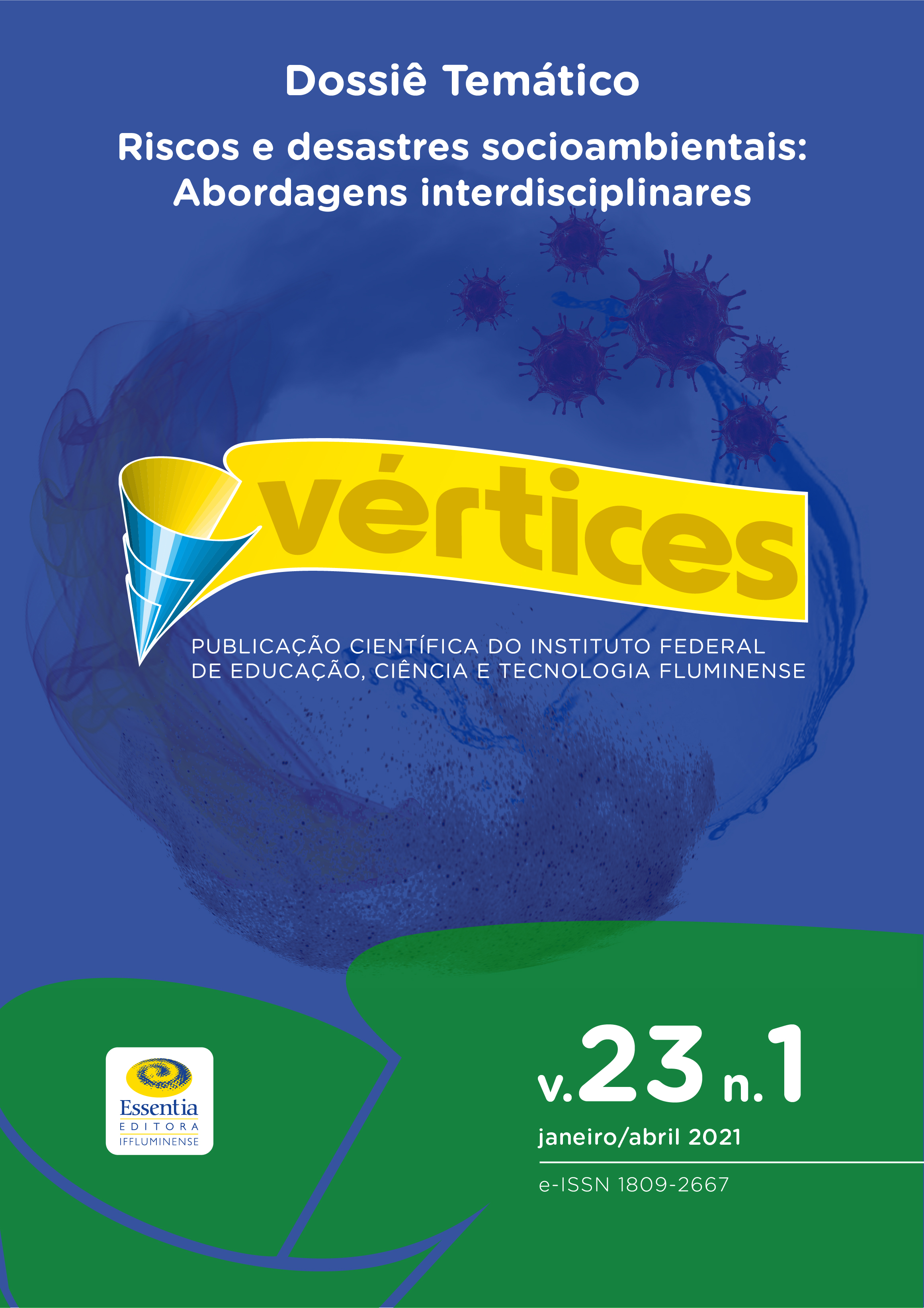Experiencing environmental changes with multiple players and taking a critical look
DOI:
https://doi.org/10.19180/1809-2667.v23n12021p284-298Keywords:
Experiences, Environmental changes, Local populationsAbstract
Our reflection on environmental changes analyzes the action of art collectives in alternative spaces in which subjects are affected by floods derived from rivers with hydraulic dams and by contamination of terrestrial and aquatic ecosystems by tailings arising from the rupture of an ore dam. Apart from affecting socio-economic activities (fishing in particular), they impact the lives of individuals as a whole. Risk situations regarding health, floods, and disasters will be treated with a cross-cutting approach of experiences that combine anthropology, art, and territory development. We will, therefore, contemplate two interventions: a Brazilian and a European one involving artists, anthropologists, and urban planners. Our questioning should enable a new reading of the challenges for the balanced development of the territories that will work together with the subjects (residents/fishermen of the Vila de Regência (Brazil), affected by the poisoning of the Doce river, in the Brazilian example, and the residents of a French medium-sized city, on the banks of the Loire River, submitted to the risk of flooding and participating in a risk prevention plan). In both cases, the participation of an artist collective allows an original and rich debate with local populations.Downloads
References
ARAB, N.; OZDIRLIK, B.; VIVANT, E. Expérimenter l’intervention artistique en urbanisme. Rennes: Presses Universitaires, 2016.
AUBRY, A.; BLEIN, A.; VIVANT, E. The promotion of creative industries as a tool for urban planning. International Journal of Cultural Policy, v. 21, n. 2, p. 121-138, 2015.
BLANC, N.; BONIN, S. Grands barrages et habitants. Paris: Maison des Sciences de l’Homme et Editions Quae, 2008.
BLANC, N.; CHARTIER, D. Les développements durables de l’Amazonie. In: BLANC, N.; BONIN, S. Grands barrages et habitants. Paris: Maison des Sciences de l’Homme et Editions Quae, 2008. p. 169-190.
BLANC, N.; LOLIVE, J. Vers une esthétique environnementale: le tournant pragmatiste. Natures Sciences Sociétés, v. 17, p. 285-292, 2009.
BUROWOY, M. Revisits. An outline of a theory of reflexive ethnography. American sociological review, v. 68, p. 645-679, 2003.
CERNEA, M. M. Penser les risques sociaux du développement. In: BLANC, N.; BONIN, S. Grands barrages et habitants. Paris: Maison des Sciences de l’Homme et Editions Quae, 2008. p. 57-76.
COLETIVO LÍQUIDA AÇÃO. Foz Afora: Residência artística no Rio Doce. Apoio Itaú Cultural, 2017.
CREADO, E. S. J. et al. Modos de olhar, contar e viver. In: MILANEZ, B.; LOSEKAN, C. Desastre no Vale do rio Doce: antecedentes, impactos e ações sobre a destruição. Rio de Janeiro: Folio Digital, Letra e Imagem, 2016.
DALMASSO, A. Ingénieurs et habitants autour des barrages alpins. In: BLANC, N.; BONIN, S. Grands barrages et habitants. Paris: Maison des Sciences de l’Homme et Editions Quae, 2008. p. 141-156.
DEWEY, J. Art as Experience. Trad. fr.: Oeuvres philosophiques. III. L’Art comme expérience. New York: Berkley Publishing Group; Tours, Farrago/Pau: Publications de l’Université de Pau, 2005.
FAURE, A. Écouter les voix de la Vallée: les riverains de la Dordogne. In : BLANC, N.; BONIN, S. Grands barrages et habitants. Paris: Maison des Sciences de l’Homme et Editions Quae, 2008. p. 101-124.
IBGE. Cidades. 2021. Disponível em: https://cidades.ibge.gov.br/brasil/es/linhares/panorama. Acesso em: 6 fev. 2021.
LITTLE, P. E. Abundance is not Enough: Water-related Conflicts in the Amazon River Bassin. Brasília: Universidade de Brasília, 2003. 23p. (Série Antropologia).
LITTLE, P. E. Ecologia política como etnografia: um guia teórico e metodológico. Horizontes Antropológicos, Porto Alegre, ano 12, n. 25, p. 85-103, jan./jun. 2006.
MARCUS, G. E. Multi-sited ethnography: Five or six things I know about it now. In: MARCUS, G. E. Multi-sited ethnography: problems and possibilities in Translocation of research Methods. Oxford: Routledge, 2011. p. 16-34.
OKAMURA, C.; LOLIVE, J. Construir e experimentar métodos participativos para desenvolver uma cultura de risco em São Paulo. Territorium, n. 22, p. 55-64, 2015.
RANCIÈRE, J. Le partage du sensible: Esthétique et politique. Paris: éditions La Fabrique, 2000.
RANCIÈRE, J. Le spectateur émancipé. Paris: La Fabrique, 2008.
REIS, R. L. P. R. Caboclo Bernardo: história e cultura na Barra do Rio Doce. Linhares, ES: Unilhares, 2003.
SANTOS, B. de S. O fim do império cognitivo: a afirmação das epistemologias do Sul. Belo Horizonte: Autêntica Editora, 2019.
WATEAU, F. Reproduire un village à l’identique: Alqueva. In: BLANC, N.; BONIN, S. Grands barrages et habitants. Paris: Maison des Sciences de l’Homme et Editions Quae, 2008. p. 77-100.
Published
Issue
Section
License
The authors of the manuscript submitted to Vértices, hereby represented by the corresponding author, agree to the following terms:
The authors retain the copyright and grant Vértices the right of first publication.
At the same time the work is licensed under the Creative Commons Attribution 4.0 International License, allowing third parties to copy and redistribute the material in any medium or format and to remix, transform, and build upon its content for any legal purpose, even commercially, provided the original work is properly cited.
Authors will not receive any material reward for the manuscript and Essentia Editora will make it available online in Open Access mode, through its own system or other databases.
Authors are authorized to enter into additional contracts separately for non-exclusive distribution of the version of the work published in Vértices (eg, publish in institutional repository or as book chapter), with acknowledgment of authorship and initial publication in this journal.
Authors are permitted and encouraged to disseminate and distribute the post-print (ie final draft post-refereeing) or publisher's version/PDF at online information sources (eg, in institutional repositories or on their personal page) at any time after the first publication of the article by Vértices.
Essentia Editora may make normative, orthographic and grammatical changes in the originals in order to maintain the standard language, with the final consent of the authors.
The content and opinions expressed in the manuscript are the sole responsibility of the author (s).























1.png)



